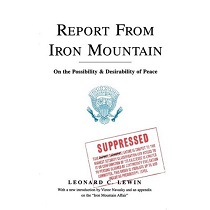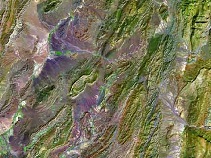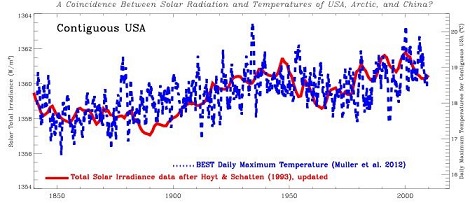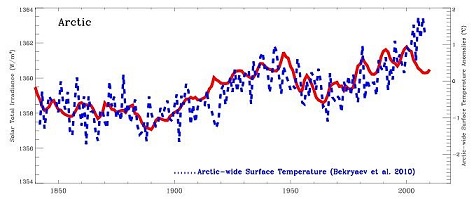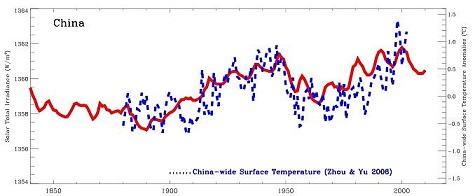Changing sun, changing climate
Bob Carter, Willie Soon & William Briggs

Scientists have been studying solar influences on the climate for more than 5000 years.Chinese imperial astronomers kept detailed sunspot records, and noticed that more sunspots meant warmer weather. In 1801, celebrated astronomer William Herschel, the first to observe Uranus, noted that when there were fewer spots the price of wheat soared. He surmised that less “light and heat” from the sun resulted in reduced harvests.
It is therefore perhaps surprising that Professor Richard Muller (University of California, Berkeley) recently claimed that “no component that matches solar activity” could be identified in his newly reconstructed BEST global land temperature record. Instead, Professor Muller said, carbon dioxide controls our changing temperature.
Can it really be true that solar radiation, which supplies Earth with the energy that drives our weather and climate – and which, when it varied in the past, is known to have caused major climate shifts – is no longer the principal influence on climate change?
Consider the charts that accompany this article. In locations as widely separated as US, the Arctic and China, they show a strong and direct relationship between temperature and incoming solar radiation -- the data for the US coming directly from Professor Muller’s own BEST data! That such a tight relationship between temperature and solar radiation holds for many disparate geographical areas indicates that the US result cannot be dismissed as just a local aberration.
A strong sun-climate relationship requires mechanisms to exist whereby our sun can both cool and warm the Earth. One such mechanism is fluctuations in the total amount of incoming solar energy, but measurements suggest that this is not a dominant effect. Another cause, and probably a more substantial one, is modulation of the amount of solar radiation that reaches earth’s surface by changes in total cloud cover.
Recent work by NCAR senior scientists Drs. Harry van Loon and Gerald Meehl has also emphasized a physical relationship between incoming solar radiation and temperature. These scientists argue indirectly that, in testing for this relationship, daytime maximum temperature is the most appropriate criterion to use to characterize the temperature. This measure is available for the US from the BEST data set, and has therefore been used in plotting the accompanying graph below.
The reason why many previous studies have failed to identify a strong sun-temperature link may be that they have used the daily average temperature to represent the temperature component of the relationship. This can easily introduce erroneous complications related to the part of each day when the sun shines on the other hemisphere and darkness prevails at any particular site being studied.
Nevertheless, recent analyses indicate that even small changes in incoming solar radiation can have a strong effect on Earth’s temperature and climate. In 2005, research by one of us (Soon) demonstrated the existence of a strong correlation between solar radiation and the anomalies in average temperature for the Arctic over the past 130 years (below).
Since then, we have demonstrated that similar correlations exist for all of the regions that surround the Arctic, including the US mainland and China (below).
The reconfirmation now of a strong sun-temperature relation based specifically upon the daytime temperature maxima adds strong and independent scientific weight to the reality of the sun-temperature connection.
The close relationships between the abrupt ups and downs of solar activity and similar changes in temperature that we have identified occur locally in coastal Greenland; regionally in the Arctic Pacific and north Atlantic; and hemispherically for the whole circum-Arctic region. This suggests strongly that changes in solar radiation drive temperature variations on at least a hemispheric scale.
Close correlations like these simply do not exist for temperature and changing atmospheric CO2 concentration. In particular, there is no coincidence between the measured steady rise in global atmospheric CO2 concentration and the often dramatic multi-decadal (and shorter) ups and downs of surface temperature that occur all around the world.
Ongoing research in collaboration with Professor David R. Legates of the University of Delaware, provides a self-consistent explanation for these apparent sun-climate correlations. Our hypothesis involves exchanges of heat and moisture between the equator and the Arctic region.
Direct evidence now exists that changes in solar activity have influenced what is called the “conveyor-belt” circulation of the great Atlantic Ocean currents over the past 240 years. Interestingly, it transpires that solar-driven changes in temperature, and consequential changes in the volume of freshwater released from the Arctic, cause variations in sea surface temperature in the tropical Atlantic 5-20 years later. That this time lag was not taken into account in earlier sun-climate relationship studies is another reason for their comparative lack of success.
The new peer-reviewed scientific results about sun-climate relationships summarized above are of disparate nature and are obtained with independent datasets stem from several different research groups. Considered together, this new research renders implausible the prevailing assumption that changes in solar activity play no (or only an insignificant) role in climate change.
The hallmark of good science is the testing of plausible hypotheses that are then supported or rejected by evidence gathered from either observation or experiment. The evidence from BEST's newly analysed data, and from our own and other published studies, is strongly consistent with the hypothesis that solar factors are the major cause of multidecadal climate change, especially in the northern hemisphere circum-Arctic regions.
Incidentally, but importantly, BEST's own data also clearly invalidate the alternative hypothesis that CO2 is the most important cause of observed temperature changes across the USA.
In a nutshell, climate is always changing and it is the sun wot does it.
___________________________________________________________________________________
Willie Soon has been researching the relationship of solar radiation and Earth’s climate at the Harvard-Smithsonian Center for Astrophysics for the past 22 years. William M. Briggs is a meteorology-trained statistician and former associate editor of the Monthly Weather Review. Bob Carter is author of the book Climate: the Counter Consensus, and an Emeritus Fellow of the IPA.
___________________________________________________________________________________
Article published here: Quadrant Online. Photograph: David Silverman/Getty Images
URL: http://www.a-w-i-p.com/index.php/2013/03/31/changing-sun-changing-climate




